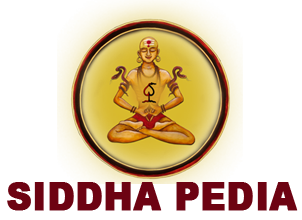Indra
Indra (Sanskrit: इन्द्र) means immovable or unshakable. It signifies the power or strength of the deity. He is also known by the name Śakra means the one who is capable. Indra is the king of the Devas residing in Swarga. Indra Dev is the ruler or king of all the 14 lokas or realms that exist within this universe. He is the lord of life energy (Jeevani Shakti) and the deity who bestows prāṇa — the vital life force in to all living beings. Indradev presides over a grand celestial court ( divya raaj darbaar ). In this divine assembly, countless devas and devis, celestial beings, gandharvas, apsaras, and divine attendants from all lokas (realms) are present which collectively are called Dev Mandala. They all function in harmony under Indra’s guidance and command. Each of them carries out their cosmic duties and responsibilities as per the directions of Devarāja Indra, maintaining the order and balance of the universe.
In Siddha Dharma as per the great Mahasiddha Koshira Nath ji, the consciousness that obtains all the experiences through the senses of the being is also called Indra. In this universe, all that is most valuable, most precious, and truly exceptional—be it the highest forms of knowledge, wisdom, divine herbs, medicines, rare crystals and stones, or the most refined arts and sciences—are all under the lordship of Indra Dev. He is the sovereign keeper of these supreme treasures, holding them within his celestial treasury. The guardian deity of all these treasures is none other than Bhagwān Kubera, the protector of celestial wealth and knowledge.
In the Siddha Dharma tradition, when Kaulantak Nath performs the sadhana of Bhagwati Kurukulla while adorned in his royal attire, he is regarded as a aspect or ansh of Devraj Indra. That is why, within Kaulantak Peeth as well, Kubera is revered as the protector deity of the highest and most esoteric wisdom. This tradition stems from an ancient event when Bhagwan Indra once came to the Peeth to undertake the sadhana of Bhagwati Kurukulla. At that time, there was no presiding Peethadheeshwar, so Devraj Indra was temporarily appointed as the Peethadheeshwar. Clad in his royal attire, Devraj Indra performed the sadhana of Bhagwati Kurukulla, establishing this sacred precedent.
No Kaulantak Nath can fulfill the Rājadharma (divine royal duty) without first undertaking the sādhana (spiritual discipline) of Indra Dev. It is only through Indra’s grace that one can truly uphold and govern the spiritual sovereignty that Kaulantak Nath embodies.
It is popularly believed that Devraj Indra can bestow immense worldy pleasures on his devotees but he is not capable of granting the highest states like liberation (mukti), siddhatva or moksha. But this a myth. According to Siddha Dharma, Bhagwan Indra is the deity who rigorously tests the seeker before granting anything of true value. His belief is unwavering—that in this world, nothing sacred should fall into unworthy hands, whether it be wisdom, prosperity, or even the supreme states like liberation and siddhatva.
Unlike the Tridev—Brahma, Vishnu, and Mahesh—or the Tridevis, who, out of compassion, sometimes bestow divine gifts even without testing the being thoroughly, Indra stands apart. At times, he even opposes the will of the Tridevas, firmly holding that no boon should be granted without discernment.
This is why, those who undertake the sādhana (spiritual discipline) of Devraj Indra begin to experience all the pleasures and enjoyments of this material world—because Indra, as the king of the gods, governs the domain of worldly abundance, joy, and celestial wealth.
But only when a seeker rises above these pleasures, mastering detachment and overcoming desire, does Indra grant the seeker higher states like liberation (mukti) or siddhatva. Unless this transcendence is achieved, Indra withholds such ultimate rewards, ensuring that only the truly deserving attain the highest truth. Therefore he is also given the name Amoghratna i.e. he is the one who posseses the ultimate ratns in the form of the supreme knowledge that is capable of providing the mukti to the recipient.
Origin
Contents
According to Siddha Dharma
According to Kurukulla Kalpa in Siddha Dharma tradition there are sixteen deities in the cosmos who manifested spontaneously (Swayambhu). They are called “ayonija” meaning not born from the womb of any being in the universe.
In the beginning, there was only Brahman along with Yogamaya, in their formless (nirakar) state. When they assumed the manifest (sakar) form as Brahma, this Brahma expressed the desire to create the universe. In response to this desire, Yogamaya manifested the Tridevas — the three foundational forces of creation.
Swachchhand bhairav Bhagwan Shiv ( Rudra ) appeared but he was in invisible form. Then Sheshanāga appeared. Upon him appeared Lord Vishnu, who governs preservation. From Vishnu’s navel, Bhagwan Brahmā emerged, who became the agent of creation.
From Vishnu’s eyes, the Goddess herself manifested in the form of Kurukulla, embodying divine charm, attraction, and supreme knowledge. From the impurities of Vishnu’s ears, the demons Madhu and Kaitabha were born.
At that time, the cosmos was engulfed in deep darkness. To dispel this darkness, Yogamaya manifested a pillar of divine light (Prakash Stambha), which was none other than Swachchhand Bhairava Bhagwan Shiva (Rudra) in his visible form.
To govern this universe, the nature, all the devtas and all other beings that are being created in different realms, one leader had to be appointed. So Swachchhand bhairav Bhagwan Shiv created Mahaindra from himself.
However, Maha Indra declared that he always wished to remain in his original Brahmic (transcendental) form. Therefore, he established a system — the system of the Indra post — and decided that in every Manvantara (cosmic age), the most exalted consciousness from within this very universe, one who has attained the highest merit through supreme virtuous actions and intense spiritual austerities, would be granted the position of Indra for that Manvantara.
This chosen being would then reside in Indrapuri and govern all the worlds during that period. Since such individuals are appointed by the eternal Maha Indra, they too are referred to as Indra.
However, the original and eternal Maha Indra remains in his divine transcendental realm, beyond the material cosmos. The Indra that is mentioned in Vedas is actually the Mahaindra.
The pauranik story
Indra’s father is Kashyapa Rishi. He is one of the Saptarishis, a great progenitor (Prajapati), and a revered sage. His mother is Aditi, one of the daughters of Daksha Prajapati.
According to Rigveda and Puranic texts Kashyapa Muni married several daughters of Daksha Prajapati, among whom Aditi and Diti are most significant.
Aditi was devoted and virtuous. When the Daityas (asuras), born from her sister Diti, began to gain dominance in the universe, Aditi was disturbed by the growing imbalance.
She performed severe penance and worshipped Bhagwan Vishnu for the protection of dharma and the restoration of cosmic balance.
Pleased with Aditi’s austerities, Vishnu blessed her with the divine boon and then Aditi, gave birth to the Adityas—a group of solar deities including Indra, Varuna, Mitra, Aryaman, Bhaga, Savitr, and other. Indra was born as the chief among the Adityas, destined to lead the Devas and combat the forces of adharma (chaos and injustice).
Indra married Shachi. Shachi is the daughter of the asura Puloman. Indra and Shachi had three sons named Jayanta, Rishabha, Midhusha and two daughters, Jayanti and Devasena. Devasena marries bhagwaan Kartikeya. And Jayanti becomes the wife of Shukra.
Iconography
Indra is shown holding a thunderbolt or Vajra and a sword. He is sitting on top of his elephant Airavata, which reinforces his characteristic as the King of the Gods. He is adorned with the most precious of the jewelleries and clothes from the treasury of Bhagwan Kubera.
He is shown holding the following weapons –
1. Vajra (वज्र) – Thunderbolt / Diamond Weapon
Most iconic weapon of Indra.
Forged by Tvaṣṭṛ, the celestial architect, from the bones of Maharishi Dadhichi.
2. Ankusha (अंकुश) – Elephant Goad
Symbol of royal authority and control over powerful forces (both external and internal).
3. Bow of Indra (Indradhanush or Śakradhanus)
Indra is sometimes depicted with a celestial bow, particularly in epic battles.
Indra’s bow creates the rainbow, symbolizing a divine covenant or victory.
4. Net of Indra (Indrajāl or Indra’s Net)
A metaphysical weapon representing the interconnectedness of all reality, with each node reflecting all others.
Symbolically, it’s a web of illusion or maya, but also of divine perception.
The Legends of Indra
The Legend of Indra and Vṛitrāsur
This history begins with Rishi Tvaṣṭā. Rishi Tvaṣṭā married a woman from the asura clan. They had a son named Viśvarūpa.
He was appointed as the priest (purohita) of the devas after Devguru Bṛhaspati temporarily withdrew.
Indra and the devas grew suspicious of Viśvarūpa because of his maternal asura heritage. Despite his role as their priest, they feared he might harbor secret sympathies for the asuras.
According to the Bhagavata Purana Viśvarūpa was secretly offering oblations (havis) to both the devas and the asuras during rituals. This act of dual loyalty was considered a breach of dharma, especially for one in a priestly position. Feeling betrayed and threatened, Indra beheaded Viśvarūpa this killing him.
Tvaṣṭā, Viśvarūpa’s father, was enraged. To avenge his son, he performed a yajña (sacrifice) to create a being who would destroy Indra. However, due to a mispronunciation of the mantra, instead of creating someone who would “kill Indra,” he created someone “who would be killed by Indra” — Vṛitrasura.
Vṛitra’s name means “the one who covers or restrains,” and he lived up to it by committing a deed that would shake the heavens and plunge the earth into distress: he seized all the waters of the world.
The rivers stopped flowing. Rain ceased to fall. The clouds hung heavy in the sky, bound by Vṛitra’s force. The fertile lands turned barren, and life across the earth began to wither. Vṛitra built a fortress of stone and darkness, enclosing the life-giving waters within, and refused to let them flow. Without rain and rivers, the balance of the world was disturbed.
The gods of the heavens were anguished.
But even Indra, mighty as he was, could not defeat Vṛitra on his own. The asura was protected by a boon granted to him by Bhagwan Brahma, which made him immune to all weapons made of wood or metal, stone or bone. No ordinary weapon could touch him.
Therefore a weapon named Vajra was created from the bones of the great Shiv devotee Maharishi Dadhichi. It was with the help of Vajra, Devraj Indra killed the asura Vritrāsur.
The waters of the world—rivers, rains, clouds—were released.
Indra and the Vala Cave
A group of demonic beings known as the Páṇis—mischievous, greedy hoarders—had stolen something of immense value from the gods and the world: the sacred cows, the rays of light, the voices of the dawn. These were not ordinary cows but symbolic representations of divine radiance, knowledge, and abundance. They embodied speech (Vāk), light, truth, and life-giving power. The Panis, driven by their nature, hid these sacred cows inside a dark and impenetrable cave, known as Vala.
This cave was not just a physical location—it was a fortress of silence, concealment, and spiritual darkness. The light of the world had been swallowed. The divine cows, whose very movement gave rhythm to creation, were silenced. Their absence plunged the world into stagnation and twilight.
The devas were dismayed. Without the cows, the sun would not rise, dawn would not break, and life would not flourish. The cycle of day and night, truth and speech, became distorted.
In this moment of divine crisis, the gods once again turned to the Indra.
Indra had already proven his strength by slaying the asura Vṛitra and releasing the waters of the world. Now, the gods pleaded with him to take up arms again to defeat the pānis.
Indra listened, and with his vajra (thunderbolt) in hand, he mounted Airāvata, his celestial elephant, and prepared to storm the cave of Vala. But this task required more than brute force—it needed wisdom, speech, sound, and divine assistance.
So, Indra called upon the Angirasa Rishis, ancient seers of luminous wisdom. The Angirasas were known for their power of mantra—sacred sound that could penetrate darkness and invoke divine forces. Their chants were said to awaken even the deepest silence.
Together, Indra and the Angirasas approached the sealed Vala cave. Inside, the Panis guarded the cows fiercely, mocking the gods and hiding in their self-made illusion of power.
Indra raised his vajra and thundered, but the cave did not yield easily. The Panis had sealed it with spells of silence, illusions, and confusion. Then came the Angirasas, who began to chant the sacred hymns of the Vedas.
The vibrations awakened the cows, and light began to stir within the darkness. Indra, empowered by both divine force and sacred sound, struck with his vajra. The mountains trembled, and the walls of the Vala cave burst open.
As the cave split, streams of radiant cows surged forth like beams of sunlight at dawn. Along with them emerged Uṣas, the goddess of dawn herself, who had been trapped in the darkness. Her return marked the rebirth of morning, the reappearance of hope, and the reestablishment of the cosmic cycle.
The Panis tried to flee, but their power had been broken. But what mattered most was that light had returned, truth had been released, and divine speech had once again found its voice.
The fourteen Indras
Mahāindra eternally abides in his transcendental Brahmic form, beyond all limitations of time, space, and matter. He never takes birth in this universe, nor is he subject to the cycle of birth and death. Free from all karmic bonds, he remains ever-established in his divine, immutable state. However, for the governance and sustenance of the cosmos, he has created a post called Indra.
Indra is not a single eternal deity, but a title—the king of the gods during each Manvantara, which is a vast cycle of time governed by a specific Manu. There are 14 Manvantaras in one Kalpa (a day of Brahma), and each Manvantara has its own Indra, Manu, Saptarishis, and other divine beings.
Here is the list of the 14 Indras—each ruling in one Manvantara—according to the Puranas like the Vishnu Purana, Bhagavata Purana.
1. Yajña ( यज्ञ ) – Indra of the first Manvantara (Swayambhuva Manu)
He is an incarnation of Vishnu himself.
2. Vipaschit ( विपश्चित् ) – Indra of the second Manvantara (Svārochiṣa Manu)
3. Shikhi ( शिखि ) – Indra of the third Manvantara (Uttama Manu)
4. Sambhu ( शम्भु ) – Indra of the fourth Manvantara (Tāmasa Manu)
5. Shanti ( शान्ति ) – Indra of the fifth Manvantara (Raivata Manu)
6. Amrita Dhara ( अमृतधारा ) – Indra of the sixth Manvantara (Chākshusha Manu)
7. Purandara ( पुरन्दर ) – Indra of the seventh (current) Manvantara (Vaivasvata Manu)
This is the most well-known Indra from the Vedas and Puranas. He is the one who slew Vṛitra and released the rivers. He is still the reigning Indra in our current cosmic era.
8. Bali ( बलि ) – Indra of the eighth Manvantara (Sāvarṇi Manu)
The asura king Bali, who was granted sovereignty over heaven by Vishnu after the Vamana avatar.
9. Adbhuta ( अद्भुत ) – Indra of the ninth Manvantara (Dakṣa Sāvarṇi Manu)
10. Shanti ( शान्ति ) – Indra of the tenth Manvantara (Brahma Sāvarṇi Manu)
Same name as the Indra of the 5th Manvantara, but a different being.
11. Vish ( विश् ) – Indra of the eleventh Manvantara (Dharma Sāvarṇi Manu)
12. Ritudhama ( ऋतुधाम ) – Indra of the twelfth Manvantara (Rudra Sāvarṇi Manu)
13. Devaspati ( देवस्पति ) – Indra of the thirteenth Manvantara (Deva Sāvarṇi Manu)
14. Shuchi ( शुचि ) – Indra of the fourteenth Manvantara (Indra Sāvarṇi Manu)
Indra Dev in Vedas and Puranas
In the Vedas and Upanishads, Bhagwan Indra holds immense significance as one of the most prominent and powerful deity. About 250 more than 250 hymns in rigveda praises Indra Dev.
The hymns portray him as the one who dispels the darkness by releasing the sun from the grip of the clouds, melts the grip of winter to awaken warmth in the earth. He cleaves mountains to free the rivers, blesses the land with fertility, and fills the cows with nourishing milk. Indra breathes life into the static, making it vibrant and abundant. Above all, he is revered as the a very compassionate deity who clears every hurdle from the path of human advancement, allowing life to flourish and move forward. He also helps the humans to grow in their spiritual journey.
Mahasiddhas of Indra Sadhana
In himalayan Siddha Dharma there are two school of thoughts of Mahasiddhas about Mahāindra and Indra. Some of the Mahasiddhas believe that Mahāindra is superior to the tridevas ( Bhagwan brahmā, Vishnu, Mahesh) while the other Mahasiddhas say that Mahāindra is equivalent to the trinity. However this is certain that there is huge importance of Indra in Siddha dharm. All the rituals that we perform, the karmkand that we do contains the worship of Indra. Without Indra the homa or yagya does not succeed.
Mahāindra and Indras of different manavantaras have bestowed the Mahasiddhas with extraordinary and very significant knowledge and sadhnas that were then incorporated into Siddha Dharm.
The eighteen principal Mahasiddhas of Siddha Dharma, who laid the foundational framework of the Hinalayan Siddha tradition, were the ones who formulated a specific method of Indra Sadhana and incorporated it into Siddha Dharma. The first to undertake the Mahāindra (Great Indra) Sadhana was Mahasiddha Adi-Hiranyagarbha Nath Ji (not to be confused Mahasiddha Hiranyagarbhnath and Mahasiddha param Hiranya nath, these 3 Mahasiddhas have similar names). Thereafter, Mahasiddha Koshira Nath Ji practiced it and further simplified the method so that the Indra Sadhana could become more accessible to practitioners.
| SL No. | Image | Name of the Mahasiddhas (English) | Name of the Mahasiddhas (Hindi) | |
|---|---|---|---|---|
| 1 | 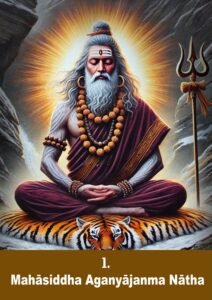 | Mahāsiddha Aganyajanma Nātha | महासिद्ध अगण्यजन्म नाथ | ब्रह्मसिद्ध |
| 2 |  | Mahāsiddha Dharmalohita Nātha | महासिद्ध धर्मलोहित नाथ | ब्रह्मसिद्ध |
| 3 |  | Mahāsiddha Vamakharpari Nātha | महासिद्ध वामखर्परी नाथ | ब्रह्मसिद्ध |
| 4 |  | Mahāsiddha Vajraheeraka Nātha | महासिद्ध वज्रहीरक नाथ | ब्रह्मसिद्ध |
| 5 | 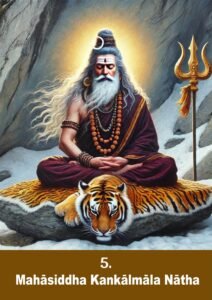 | Mahāsiddha Kankaalmaala Nātha | महासिद्ध कंकालमाल नाथ | ब्रह्मसिद्ध |
| 6 |  | Mahāsiddha Vivswana Nātha | महासिद्ध विवस्वान नाथ | ब्रह्मसिद्ध |
| 7 | 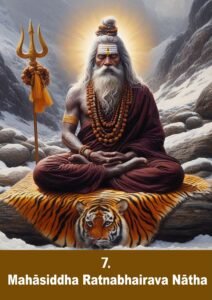 | Mahāsiddha Ratnabhairava Nātha | महासिद्ध रत्नभैरव नाथ | ब्रह्मसिद्ध |
| 8 |  | Mahāsiddha Mashanmushthi Nātha | महासिद्ध मशानमुष्ठि नाथ | ब्रह्मसिद्ध |
| 9 |  | Mahāsiddha Atichhatra Nātha | महासिद्ध अतिछत्र नाथ | ब्रह्मसिद्ध |
| 10 | 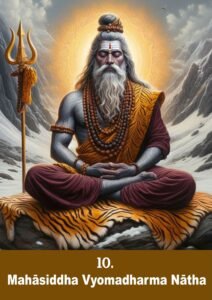 | Mahāsiddha Vyomadharma Nātha | महासिद्ध व्योमधर्म नाथ | ब्रह्मसिद्ध |
| 11 | 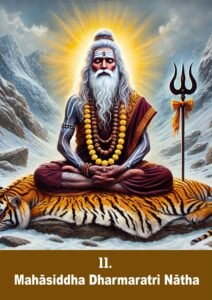 | Mahāsiddha Dharmaratri Nātha | महासिद्ध धर्मरात्रि नाथ | ब्रह्मसिद्ध |
| 12 | 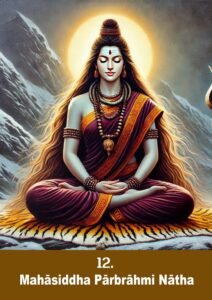 | Mahāsiddha Paarbrahmi Nātha | महासिद्धा पारब्रह्मी नाथ | ब्रह्मसिद्ध |
| 13 | 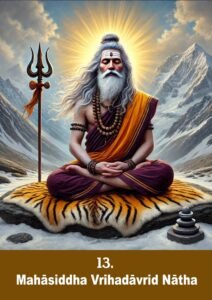 | Mahāsiddha Vrihadavrid Nātha | महासिद्ध वृहदावृद नाथ | ब्रह्मसिद्ध |
| 14 | 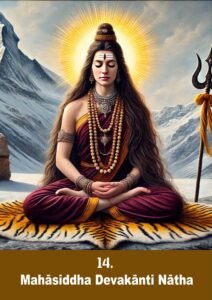 | Mahāsiddha Devakanti Nātha | महासिद्धा देवकांति नाथ | ब्रह्मसिद्ध |
| 15 |  | Mahāsiddha Jagadaagni Nātha | महासिद्ध जगदाग्नि नाथ | ब्रह्मसिद्ध |
| 16 |  | Mahāsiddha Atikrishna Nātha | महासिद्ध अतिकृष्ण नाथ | ब्रह्मसिद्ध |
Indra Kalpa Tantra
Although there may be differences in perspective among the Mahasiddhas, it is certain that all the deities—whether the Trinity, Indra, or the sixteen Swayambhu deities—are none other than that very Brahman or Yogamaya.
Everywhere, only one aspect of Indra Dev is popularly known—that he is the king of the gods. However, the Mahasiddhas have also perceived another aspect of him: that of a Guru.
The Mahasiddhas worshipped him to receive divine knowledge and advanced sadhanas. Pleased by their devotion, Indra Dev appeared in the form of a Guru and imparted to them the most secret and sacred knowledge that he possesses.
There are many esoteric tantric systems and mysterious spiritual teachings that Indra Dev revealed to the Mahasiddhas. The entire Indra Sadhana was directly given by him to them.
The Indra Kalpa Tantra is the sacred text that contains the detailed system of Indra Sadhana. This vast and deeply insightful Grantha was compiled through the collaborative wisdom of many Mahasiddhas.
Devraj Indra is the deity who inspires the seeker to attain perfection both in the material world and in the spiritual realm.
| SL No. | Chapter No. | Name (Devanagari) | Name (IAST) | Compiled By (Devanagari) | Compiled By (IAST) |
|---|---|---|---|---|---|
| 1 | Chapter 1 | देव खण्ड | Dev Khaṇḍa | महासिद्ध अगण्यजन्म नाथ महासिद्ध धर्मलोहित नाथ | Mahāsiddha Aganyajanma Nātha Mahāsiddha Dharmalohita Nātha |
| 2 | Chapter 2 | विद्या खण्ड | Vidyā Khaṇḍa | महासिद्ध वामखर्परी नाथ महासिद्ध वज्रहीरक नाथ | Mahāsiddha Vamakharpari Nātha Mahāsiddha Vajraheeraka Nātha |
| 3 | Chapter 3 | माया खण्ड | Māyā Khaṇḍa | महासिद्ध कंकालमाल नाथ महासिद्ध विवस्वान नाथ | Mahāsiddha Kankaalmaala Nātha Mahāsiddha Vivswana Nātha |
| 4 | Chapter 4 | गुह्य खण्ड | Guhya Khaṇḍa | महासिद्ध रत्नभैरव नाथ महासिद्ध मशानमुष्ठि नाथ | Mahāsiddha Ratnabhairava Nātha Mahāsiddha Mashanmushthi Nātha |
| 5 | Chapter 5 | नील खण्ड | Nīla Khaṇḍa | महासिद्ध अतिछत्र नाथ महासिद्ध व्योमधर्म नाथ | Mahāsiddha Atichhatra Nātha Mahāsiddha Vyomadharma Nātha |
| 6 | Chapter 6 | वज्र खण्ड | Vajra Khaṇḍa | महासिद्ध धर्मरात्रि नाथ महासिद्धा पारब्रह्मी नाथ | Mahāsiddha Dharmaratri Nātha Mahāsiddhaa Paarbrahmi Nātha |
| 7 | Chapter 7 | सिद्धि खण्ड | Siddhi Khaṇḍa | महासिद्ध वृहदावृद नाथ महासिद्धा देवकांति नाथ | Mahāsiddha Vrihadavrid Nātha Mahāsiddhaa Devakanti Nātha |
| 8 | Chapter 8 | श्वेत खण्ड | Śveta Khaṇḍa | महासिद्ध जगदाग्नि नाथ महासिद्ध अतिकृष्ण नाथ | Mahāsiddha Jagadaagni Nātha Mahāsiddha Atikrishna Nātha |
Deshaj tradition of Devraj Indra
People from different regions of the Himalayas have their own distinct methods of worshipping Devraj Indra, known collectively as the Deshaj Parampara (indigenous tradition). Deshaj traditions are actually prepared and promoted by Mahasiddha Koshira Nath Ji so that all the normal people who cannot do difficult and elaborate sadhanas can still obtain the divine grace of the devi devtas. As the King of the 14 Lokas (realms), Devraj Indra is worshipped in an exceptionally royal manner. The best of the best offerings are made to him — including pearls, royal brocade garments, premium fruits, and richly prepared prasad.
Barley (jau), also known as Indra grain, is traditionally offered to him. Another important offering is Sur-Som — a specially prepared juice made by grinding and filtering dried white grapes (munakka) along with the juice of other sweet fruits.
In Deshaj traditions, there are many folk songs (gīhee) that praise Devraj Indra. These are sung during Indra Puja. Since Indra is not only the king of heaven but also the holder of all the divine arts (kalās), dance (nṛitya) and music (gāyan) are also offered to him as acts of devotion.
Various dance forms are performed, such as: Bhairav dance and Bhairavi dance in group formations, Special solo dances like the Apsara dance, Kinnari dance, and others.
Another significant deity in Indra worship is Agni Dev (the Fire God). All offerings made to Indra Dev are conveyed through Agni Dev, making him a vital part of the ritual. Unlike regular yajnas (fire rituals) where the Agni Kunda (fire pit) is constructed on the ground with three steps leading into the pit, in Indra Yajna the fire pit is constructed on top of a pillar, indicating a distinct and elevated method of offering.
Numerous ghee lamps (diyas) are lit in honor of Indra Dev during his worship.
A very significant element in the sadhana (spiritual practice) and worship of Indra is the Indra Jāl (Indra’s net or magical web). Symbolic Indra Jāls are made by weaving together threads of different colors, and these are kept in sacred places (dev sthāns). They are believed to provide protection against negative forces, including evil spirits, planetary afflictions (graha dosh), enemies, and black magic.
There is also a plant called Indrajaal, though in dev traditions, it is often considered inauspicious. However, the thread-made Indra Jāl is regarded as highly auspicious and spiritually potent.
In remote Himalayan villages, Shamans of Indra are still found. They invoke the blessings of Indra by various methods including building of rathas, malimukhas, masks etc. These spiritual practitioners invoke the grace of Indra Dev for various purposes — to ensure good rainfall, the flourishing of fruits and vegetables, the blessing of a child, and more.
Some highly advanced Shamans, due to their deep sadhana and connection with Indra Dev, are even capable of receiving divine knowledge and wisdom directly from him.
One more sacred offering to the world from Indra Dev is the Indra Nīti — a divine system of ethics and governance. Indra Nīti contains the codes of conduct, laws, and royal duties that a righteous king must follow according to Dharma.
All the divine and supreme things in this universe are under the lordship of Devraj Indra like – Stones or Ratnas like Kaustubha Ratna, Chintamani Ratna, Syamantaka Mani, Padmaraga, Mukutmani, Vajraratna, Maniratna, Moti (Pearls), Indradhvaja Ratna, Hiranya Ratna. He also posseses Indradhvaja, Kamadhenu, Kalpavriksha, Uchchaihshravas, Airavata, Apsaras, Gandharvas, Nandana Vana, Amrita, Vajra, Simhasana, Soma, Indra Nīti, Siddhis, Kalās, Parijata Tree. This list is endless and unlimited.
Another one of the most esoteric method of worshiping Indra Dev in the Deshaj Parampara (indigenous tradition) is known as “Ākāsh Pooja” — the Worship through the sky. In this ritual, the sādhak (spiritual practitioner) sits under the open sky, and all the offerings (āhutis) are directed upward toward the sky, symbolically offering them to Indra Dev who resides in the celestial realms.
Another tradition observed in the interior Himalayan regions involves devotees visiting various sacred sites of Indra Dev to have his darshan (divine vision) and perform ritual worship to please him. During this sacred journey, the practitioner follows strict disciplinary vows to invoke Indra Dev’s grace. Some of the practices include: Eating only once a day, Consuming only prasad (sanctified offerings), Not wearing footwear. And observing several other austerities and vows (niyam) specific to this tradition
These acts of devotion and restraint are believed to purify the practitioner and help them draw closer to Indra Dev’s divine presence.
